



303(d) Listing Methodology September 25, 2012 Application of the Integrated Impact Analysis Tool
Setting the Stage • MMI provides a score to characterize macroinvertebrate health. • What does it mean if my segment has a low score? • What do I do if I get on the 303(d) list because of my MMI score? • What is really causing the change in biological health that I am seeing in my segment? • Is the nutrient level in my segment impacting the biology or is it the fact that my stream is wide, straight, and nearly dry half of the year?
Integrated Impact Analysis • WERF project (partly funded by EPA) to distinguish the relative impact of chemistry and habitat on aquatic life (Project 98-WSM-1). • Answered the question: How do I determine the relative impact of chemical and habitat stressors on the biology in my stream? • Teamed with GEI (Chadwick) and Risk Sciences (Tim Moore). • Has been used in Santa Ana UAA, Arid West work, Southeastern Wisconsin Watershed Trust, and by GEI often in their biological work.
Topics to Cover • How would this model be used to detect impairments? • Would it be more useful for stressor identification after an impairment has been identified? • Would the model be the basis for stand-alone listing decisions or would it be used in conjunction with other lines of evidence? Brown and Caldwell 4
Integrated Impact Analysis Physical Chemical + = Biological
IIA – The Gist • Uses existing statistical methods • Principle Components Analysis • All Possible Regressions • Chi-Square Automatic Interaction Detection (CHAID) • Results identify key stressors and their relative impact. • Don’t try this at home without a keen interest in statistics . . .
Basic Steps of IIA Apply Basic Statistics Identify Key Stressor and Response Variables Rank Variables According to Relative Impact Fit Equation to Describe Interactions Between Stressors MODEL and Response Repeat Cycle if More Variables Are Needed
Step 1 Apply Basic Statistics • Perform basic descriptive statistics and develop graphics • Normalize data as needed – develop new descriptive statistics and new graphics • Compile a correlation matrix
Water Chemistry Basic Statistics
Habitat Basic Statistics
• Looking for correlations (≥0.6). • Correlated variables can act as surrogates for each other.
Step 2 Identify Key Stressor and Response Variables • Identify key independent stressor variables and relationships between variables using: • Principle Components Analysis (PCA) • All Possible Regressions • Chi-square Automatic Interaction Detection (CHAID) • Iterative process that systematically removes variables from the larger pool of variables.
Principal Components Analysis • Useful in determining how variables relate to one another – how they move in space. • If variables generally move together, one variable can act as a surrogate for the other(s).
Principal Components Analysis strongest • Look at values with an absolute value ≥0.6. • A component in PCA is a group of variables that move in the same direction. • Generally, the variable with the highest score is identified as the surrogate. • Rerun to limit number of stressors to 6 and responses to 2 or 3.
Principal Components Analysis
All Possible Regressions • Combines one response with many stressor variables into models using all combinations of the stressor variables. • Look at all combinations to see what combinations explain the greatest amount of variance with the lowest error. • Look for lowest variable count that explains the most variance.
All Possible Regressions
All Possible Regressions
Chi-Squared Automatic Interaction Detection (CHAID) • Identifies both linear and non-linear relationships between variables. • Non-parametric technique, so data should not be transformed. • Robust to missing data points.
Macroinvertebrates P/Channel Range Macroinvertebrates NH3 range
Step 3 Rank Variables According to Relative Impact • Develop matrix of key independent stressor variables and relationships found in Step 2 • Repeat Steps 2 and 3 until the two most influential independent stressor variables are identified for each dependent response variable
Rank Variables According to Relative Impact • Develop a matrix of response variables and their corresponding “important” stressor variables for each of the 3 analyses. • Look for stressors identified by multiple analyses and sort by number of analyses in common. • To help with sorting, refer back to the analyses and how strong the relationships are between the stressor and response variables.
Matrix of Ranked Stressors for Each Response
Step 4 Fit Equation to Describe How Stressors Interact • Use three-dimensional modeling program to identify specific non-linear relationship transformations
Fit Equation
Step 5 Repeat Cycle if More Variables Are Needed • Enter the residuals calculated for the response variable into a new column in dataset. • The residuals are the remainder of the of the response variable after the variability caused by the 2 stressor variables is removed. • Repeat steps 2-4 to identify the next 2 important stressor variables.
Residuals From Equation Fitting
IIA Gives You . . . • An ordered list of stressors that are causing an impact on the response variables. • A model to help predict how the response variables will change based on a change in the stressor. • An understanding of whether habitat is playing a role in limiting the response variable. • A means to make sense of what the MMI metrics are showing.
Back to the Topics . . . • How would this model be used to detect impairments? • Would it be more useful for stressor identification after an impairment has been identified? • Would the model be the basis for stand-alone listing decisions or would it be used in conjunction with other lines of evidence? Brown and Caldwell 33
Questions
Recommend
More recommend